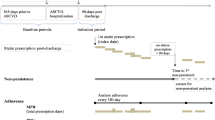Abstract
Lipid-lowering medication can significantly reduce the risk for cardiac events in patients with dyslipidemia. Despite well-publicized guidelines and the availability of potentially effective therapies, many patients do not achieve their lipid goals and remain at high risk for cardiac events because of poor adherence. To assess adherence to statin therapy based on an analysis of pharmacy records, the records of 562 patients were screened. A washout rule, designed to ensure that only new medication starts were analyzed, resulted in the inclusion of 140 records in this study. Dates of prescription fillings, drug name and strength, quantity dispensed, and the number of days supplied were recorded. Length of therapy, persistence, medication possession ratio (MPR), and median gap between prescriptions were calculated. Overall persistence declined from 56% at 9 months to 35% at 12 months. Persistence at the study end point was 34% for men, 18% for women, 19% for patients younger than 65 years, and 41% for patients aged 65 years and older. The median number of gap days between prescription refills was 6.83 for all patients and was approximately 7 days longer for women than for men. The number of gap days differed only slightly for patients younger than 65 years compared with patients aged 65 years or older (6.44 vs 7.41, respectively). MPRs ranged from 0.64 to 0.56, with no substantive between-group differences. Among the statins used most often in this study, persistence was highest with atorvastatin (36%) compared with simvastatin (26%) and pravastatin (5%). Adherence to statin therapy can result in significant improvement. In patients with dyslipidemia, personal interventions by healthcare providers can improve compliance with potentially effective therapy.
Similar content being viewed by others
References
Scandinavian Simvastatin Survival Study Group. Randomised trial of cholesterol lowering in 4444 patients with coronary heart disease: the Scandinavian Simvastatin Survival Study Group (4S).Lancet. 1994;344:1383–1389.
The Long-Term Intervention with Pravastatin in Ischaemic Disease (LIPID) Study Group. Prevention of cardiovascular events and death with pravastatin in patients with coronary heart disease and a broad range of initial cholesterol levels.N Engl J Med. 1998;339:1349–1357.
Sacks FM, Pfeffer MA, Moye LA, et al. The effect of pravastatin on coronary events after myocardial infarction in patients with average cholesterol levels.N Engl J Med. 1996;335: 1001–1009.
Shepherd J, Cobbe SM, Ford I, et al. Prevention of coronary heart disease with pravastatin in men with hypercholesterolemia.N Engl J Med. 1995;333:1301–1307.
Downs JR, Clearfield M, Weis S, et al. Primary prevention of acute coronary events with lovastatin in men and women with average cholesterol levels: results of AFCAPS/TexCAPS.JAMA. 1998;279:1615–1622.
Sever PS, Dahlof B, Poulter NR, et al. Prevention of coronary and stroke events with atorvastatin in hypertensive patients who have average or lower-than-average cholesterol concentrations, in the Anglo-Scandinavian Cardiac Outcomes Trial-Lipid Lowering Arm (ASCOT-LLA): a multicentre randomised controlled trial.Lancet. 2003;361:1149–1158.
Jackevicius CA, Mamdani M, Tu JV. Adherence with statin therapy in elderly patients with and without acute coronary syndromes.JAMA. 2002;288:462–467.
Expert Panel on Detection, Evaluation, and Treatment of High Blood Cholesterol in Adults. Executive summary of the third report of the National Cholesterol Education Program (NCEP) Expert Panel on Detection, Evaluation, and Treatment of High Blood Cholesterol in Adults (Adult Treatment Panel III).JAMA. 2001;285:2486–2497.
Pearson TA, Laurora I, Chu H, et al. The Lipid Treatment Assessment Project (L-TAP): a multicenter survey to evaluate the percentages of dyslipidemic patients receiving lipid-lowering therapy and achieving low-density lipoprotein cholesterol goals.Arch Intern Med. 2000;160:459–467.
EUROASPIRE III and Group. Clinical reality of coronary prevention guidelines: a comparison of EUROASPIRE I and II in nine countries.Lancet. 2001;357:995–1001.
Haynes RB, McDonald HP, Garg AX. Helping patients follow prescribed treatment: clinical applications.JAMA. 2002;228:2880–2883.
McDonald HP, Garg AX, Haynes RB. Interventions to enhance patient adherence to medication prescriptions: scientific review.JAMA. 2002;288:2868–2869.
Bluml BM, McKenney JM, Cziraky MJ. Pharmaceutical care services and results in project ImPACT: hyperlipidemia.J Am Pharm Assoc. 2000;40:157–165.
Day D. Use of pharmacy claims databases to determine rates of medication adherence.Adv Ther. 2003;20:164–176.
The West of Scotland Coronary Prevention Study Group. Compliance and adverse event withdrawal: their impact on the West of Scotland Coronary Prevention Study.Eur Heart J. 1997;18:1718–1724.
Insull W. The problem of compliance to cholesterol altering therapy.J Intern Med. 1997;241: 317–325.
Andrade SE, Walker AM, Gottlieb LK, et al. Discontinuation of antihyperlipidemic drugs: do rates reported in clinical trials reflect rates in primary care settings?N Engl J Med. 1995;332: 1125–1131.
Beardon PH, McGilchrist MM, McKendrick AD, et al. Primary non-compliance with prescribed medication in primary care.BMJ. 1993;307:846–848.
Akishita M, Ouchi Y, Toba K, et al. Compliance with prescriptions and adverse drug reactions in the elderly [in Japanese].Nippon Ronen Igakkai Zasshi. 1995;32:178–182.
Author information
Authors and Affiliations
Rights and permissions
About this article
Cite this article
Huser, M.A., Evans, T.S. & Berger, V. Medication adherence trends with statins. Adv Therapy 22, 163–171 (2005). https://doi.org/10.1007/BF02849887
Issue Date:
DOI: https://doi.org/10.1007/BF02849887




